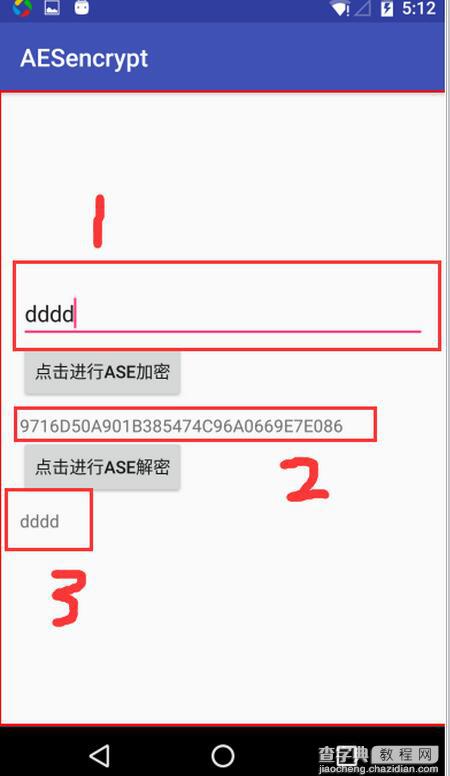今天在android项目中使用AES对数据进行加解密,遇到了很多问题,网上也找了很多资料,也不行。不过最后还是让我给搞出来了,这里把这个记录下来,不要让别人走我的弯路,因为网上绝大多数的例子都是行不通的。好了,接下来开始讲解
1、Aes工具类
package com.example.cheng.aesencrypt; import android.text.TextUtils; import java.security.NoSuchAlgorithmException; import java.security.SecureRandom; import javax.crypto.Cipher; import javax.crypto.KeyGenerator; import javax.crypto.SecretKey; import javax.crypto.spec.IvParameterSpec; import javax.crypto.spec.SecretKeySpec; /** * class description here * * @author cheng * @version 1.0.0 * @since 2016-11-02 */ public class Aes { private static final String SHA1PRNG = "SHA1PRNG"; // SHA1PRNG 强随机种子算法, 要区别4.2以上版本的调用方法 private static final String IV = "qws871bz73msl9x8"; private static final String AES = "AES"; //AES 加密 private static final String CIPHERMODE = "AES/CBC/PKCS5Padding"; //algorithm/mode/padding /** * 加密 */ public static String encrypt(String key, String cleartext) { if (TextUtils.isEmpty(cleartext)) { return cleartext; } try { byte[] result = encrypt(key, cleartext.getBytes()); return parseByte2HexStr(result); } catch (Exception e) { e.printStackTrace(); } return null; } /** * 加密 */ public static byte[] encrypt(String key, byte[] clear) throws Exception { byte[] raw = getRawKey(key.getBytes()); SecretKeySpec skeySpec = new SecretKeySpec(raw, AES); Cipher cipher = Cipher.getInstance(CIPHERMODE); cipher.init(Cipher.ENCRYPT_MODE, skeySpec, new IvParameterSpec(new byte[cipher.getBlockSize()])); byte[] encrypted = cipher.doFinal(clear); return encrypted; } /** * 解密 */ public static String decrypt(String key, String encrypted) { if (TextUtils.isEmpty(encrypted)) { return encrypted; } try { byte[] enc = parseHexStr2Byte(encrypted); byte[] result = decrypt(key, enc); return new String(result); } catch (Exception e) { e.printStackTrace(); } return null; } /** * 解密 */ public static byte[] decrypt(String key, byte[] encrypted) throws Exception { byte[] raw = getRawKey(key.getBytes()); SecretKeySpec skeySpec = new SecretKeySpec(raw, AES); Cipher cipher = Cipher.getInstance(CIPHERMODE); cipher.init(Cipher.DECRYPT_MODE, skeySpec, new IvParameterSpec(new byte[cipher.getBlockSize()])); byte[] decrypted = cipher.doFinal(encrypted); return decrypted; } /** * 生成随机数,可以当做动态的密钥 * 加密和解密的密钥必须一致,不然将不能解密 */ public static String generateKey() { try { SecureRandom secureRandom = SecureRandom.getInstance(SHA1PRNG); byte[] key = new byte[20]; secureRandom.nextBytes(key); return toHex(key); } catch (NoSuchAlgorithmException e) { e.printStackTrace(); } return null; } /** * 对密钥进行处理 */ public static byte[] getRawKey(byte[] seed) throws Exception { KeyGenerator kgen = KeyGenerator.getInstance(AES); //for android SecureRandom sr = null; // 在4.2以上版本中,SecureRandom获取方式发生了改变 if (android.os.Build.VERSION.SDK_INT >= 17) { sr = SecureRandom.getInstance(SHA1PRNG, "Crypto"); } else { sr = SecureRandom.getInstance(SHA1PRNG); } // for Java // secureRandom = SecureRandom.getInstance(SHA1PRNG); sr.setSeed(seed); kgen.init(128, sr); //256 bits or 128 bits,192bits //AES中128位密钥版本有10个加密循环,192比特密钥版本有12个加密循环,256比特密钥版本则有14个加密循环。 SecretKey skey = kgen.generateKey(); byte[] raw = skey.getEncoded(); return raw; } /** * 二进制转字符 */ public static String toHex(byte[] buf) { if (buf == null) return ""; StringBuffer result = new StringBuffer(2 * buf.length); for (int i = 0; i < buf.length; i++) { appendHex(result, buf[i]); } return result.toString(); } private static void appendHex(StringBuffer sb, byte b) { sb.append(IV.charAt((b >> 4) & 0x0f)).append(IV.charAt(b & 0x0f)); } /** * 将二进制转换成16进制 * * @param buf * @return */ public static String parseByte2HexStr(byte buf[]) { StringBuilder sb = new StringBuilder(); for (int i = 0; i < buf.length; i++) { String hex = Integer.toHexString(buf[i] & 0xFF); if (hex.length() == 1) { hex = '0' + hex; } sb.append(hex.toUpperCase()); } return sb.toString(); } /** * 将16进制转换为二进制 * * @param hexStr * @return */ public static byte[] parseHexStr2Byte(String hexStr) { if (hexStr.length() < 1) return null; byte[] result = new byte[hexStr.length() / 2]; for (int i = 0; i < hexStr.length() / 2; i++) { int high = Integer.parseInt(hexStr.substring(i * 2, i * 2 + 1), 16); int low = Integer.parseInt(hexStr.substring(i * 2 + 1, i * 2 + 2), 16); result[i] = (byte) (high * 16 + low); } return result; } }
2、mainActivity和layout文件如下:
package com.example.cheng.aesencrypt; import android.os.Bundle; import android.support.v7.app.AppCompatActivity; import android.view.View; import android.widget.EditText; import android.widget.TextView; import android.widget.Toast; public class MainActivity extends AppCompatActivity { private EditText mInputET; private TextView mShowEncryputTV; private TextView mShowInputTV; private static final String PASSWORD_STRING = "12345678"; @Override protected void onCreate(Bundle savedInstanceState) { super.onCreate(savedInstanceState); setContentView(R.layout.activity_main); mInputET = (EditText) findViewById(R.id.ase_input); mShowEncryputTV = (TextView) findViewById(R.id.show_oringe_encrypt); mShowInputTV = (TextView) findViewById(R.id.show_ase_encrypt); } /** * 加密 * * @param view */ public void encrypt(View view) { String inputString = mInputET.getText().toString().trim(); if (inputString.length() == 0) { Toast.makeText(this, "请输入要加密的内容", Toast.LENGTH_SHORT).show(); return; } String encryStr = Aes.encrypt(PASSWORD_STRING, inputString); mShowInputTV.setText(encryStr); } /** * 解密 * * @param view */ public void decrypt(View view) { String encryptString = mShowInputTV.getText().toString().trim(); if (encryptString.length() == 0) { Toast.makeText(this, "解密字符串不能为空", Toast.LENGTH_SHORT).show(); return; } String decryStr = Aes.decrypt(PASSWORD_STRING, encryptString); mShowEncryputTV.setText(decryStr); } }
layout文件
<"1.0" encoding="utf-8"?> <LinearLayout xmlns:android="http://schemas.android.com/apk/res/android" xmlns:tools="http://schemas.android.com/tools" android:id="@+id/activity_main" android:layout_width="match_parent" android:layout_height="match_parent" android:gravity="center_vertical" android:orientation="vertical" android:paddingBottom="@dimen/activity_vertical_margin" android:paddingLeft="@dimen/activity_horizontal_margin" android:paddingRight="@dimen/activity_horizontal_margin" android:paddingTop="@dimen/activity_vertical_margin" tools:context="com.example.cheng.aesencrypt.MainActivity"> <EditText android:id="@+id/ase_input" android:layout_width="match_parent" android:layout_height="wrap_content" android:hint="输入要加密的内容" /> <Button android:layout_width="wrap_content" android:layout_height="wrap_content" android:onClick="encrypt" android:text="点击进行ASE加密" /> <TextView android:id="@+id/show_ase_encrypt" android:layout_width="match_parent" android:layout_height="wrap_content" android:layout_marginTop="10dp" android:text="显示加密后的内容" /> <Button android:layout_width="wrap_content" android:layout_height="wrap_content" android:onClick="decrypt" android:text="点击进行ASE解密" /> <TextView android:id="@+id/show_oringe_encrypt" android:layout_width="wrap_content" android:layout_height="wrap_content" android:layout_marginTop="10dp" android:text="显示加密后的内容" /> </LinearLayout>
3、最后的效果如下:
1)、是一个输入框,输入钥加密的字符串;
2)、点击“AES加密”按钮后生产的加密字符串;
3)、点击“AES解密”按钮后,对加密字符串进行解密,然后在3处看到解密后的字符串,可以看到加密字符串和解密字符串相同,所以AES加解密成功了

4、总结
要用真机测试,模拟器是不行的,具体原因没去研究;
点击获取本例的github地址:
也可以通过android studio直接git下来,git地址为https://github.com/chenguo4930/AndroidAES.git
其中也还有DES、RSA的加解密demo的github地址为https://github.com/chenguo4930/EncodeDemo
git地址为: https://github.com/chenguo4930/EncodeDemo.git
以上就是本文的全部内容,希望对大家的学习有所帮助,也希望大家多多支持查字典教程网。


